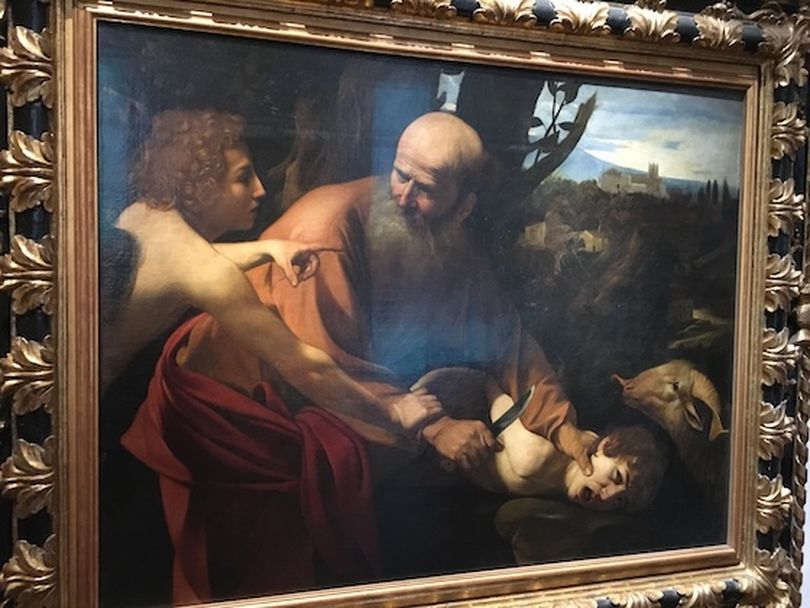Carravaggio: a master of theme and style

The first time I set eyes on a painting by the Italian artist known as Caravaggio, I was hooked. To this day, I seek out the man’s work wherever I can find it.
I don’t remember the exact year that it happened. I know it was sometime in the late 1990s. I was visiting Florence, and I remember strolling through the Uffizi – official name Le Gallerie degli Ufizzi – and being struck speechless by the artist’s painting “Sacrifice of Isaac.”
It wasn’t the first time some Italian location or work of art had affected me profoundly. Just a week before I had been standing in the middle of the Vatican City’s St. Peter’s Basilica. The immense size of the place made artistic treasures such as Michelangelo’s Pietá seem almost insignificant. Almost.
On a prior evening, my first in Rome and hit hard by jet lag, I had stumbled onto the Piazza della Rotonda. There I stood slack-jawed looking at the sight of the Pantheon, lit up by the spotlights that – cutting through the darkness – accentuated the 1,400-year-old church’s stark beauty.
And sometime during my initial stay in Florence I had experienced the thrill that affects anyone who stops by the Accademia Gallery – official name Galleria dell’Accademia – and gets a glimpse of Michelangelo’s David. Stepping around the corner and seeing that majestic marble statue is one of life’s great pleasures.
So, as I say, Italy is full of wondrous things to see. Still, to me the work of Caravaggio was – is – something special. And “Sacrifice of Isaac” particularly so.
The Bible story upon which the painting is based comes from the Old Testament, specifically the Book of Genesis. It tells the story of Abraham, who is tested by God to see how obedient he is. The test? Abraham is ordered to sacrifice his only child, Isaac.
Just as Abraham is about to do the deed, though, one of God’s angels stops his hand. Abraham, it seems, had proven his worth and no further evidence is required..
Caravaggio himself – full name Michelangelo Merisi da Caravaggio – is a controversial figure. His Wikipedia page, which includes the work of art historian Nicole Lania, reports that he “led a tumultuous life. He was notorious for brawling, even in a time and place when such behavior was commonplace, and the transcripts of his police records and trial proceedings fill many pages.”
Those transcripts include accusations of murder. And those particular accusations would lead to his mysterious death at the age of 36.
The power of his art came both from his painterly style, imbued by a masterful use of contrasting dark and light – known, I’m told, as chiaroscuro (I’m far from an art expert). Just as important, though, was the way he chose to explore themes that until then had been rendered far less realistically.
As Helen Langdon wrote in her book “Caravaggio: A Life,” “Never before had an artist presented religious drama as contemporary life ... Nor had any earlier painter dared to break so dramatically with long established studio traditions, painting his figures from nature, directly onto the canvas, with complex effects of studio lighting. It was the figures having been painted from life that most fascinated Caravaggio’s contemporaries.”
“Sacrifice of Isaac” is a case in point. Though some critics suspect that this and another version might be the work of the artist Bartolomeo Cavarozzi, the painting that sits in the Uffizi has at least one clear argument for its being an original Caravaggio: The face of Isaac in the painting has been identified as a model that Caravaggio used in several other works.
For me, the power comes not just in the painting’s realism – which, as Langdon points out, was uncommon for the time – but the very biblical theme itself. Most men I know who had difficult relationships with their fathers while growing up can relate to the pain and fear that Isaac undoubtedly feels.
In any event, whenever I go to Italy – and I’ve been there an embarrassing number of times – I seek out as many Caravaggios as I can find. During one month when I was working out of the Bloomberg company’s Rome office, which sits just off the Piazza del Popolo, I passed every morning by the Basilica of Santa Maria del Popolo. Inside are two Caravaggio paintings: “The Conversion of Saint Paul” and “The Crucifixion of Saint Peter.”
And during a visit to the Borghese Gallery and Museum – official name Galleria Borghese – I was able to see eight Caravaggios at once. Score!
But nothing the man did strikes me as powerfully as “Sacrifice of Isaac.” The Uffizi is, of course, full of masterworks. None of them, though, is more striking than this painting that Caravaggio managed to put on canvas over an eight-month period in 1603 and 1604.
As I say, I’m no expert when it comes to the fine art of painting. But I know what I like. And to say I like “Sacrifice of Isaac” is a total understatement.
